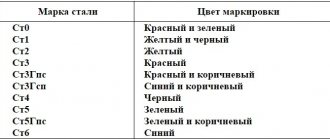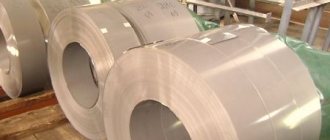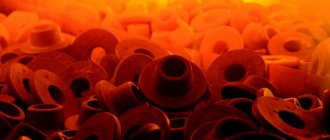Classification of stainless steels by chemical. composition:
— Chrome-nickel Household use, including kitchen utensils
— Austenitic Advantages: High strength, corrosion resistance, ductility, as well as high manufacturability. Applicable: Structural material, welding machines for aggressive environments. Steel types: 300 series. AISI 304 is a universally used steel grade, which is an analogue of 08Х18Н10, contains 8% nickel and 18% chromium. It is resistant to acid and short-term temperature increases up to 1000C. Doesn't magnetize! Application: ventilation, chimneys, storage and transportation of food, chemical reagents. Kitchenware, pipes and architectural field. AISI 316 is an improved analogue of AISI 304 with a chromium content of 16.5 to 18% and a nickel content of 10 to 13%. This combination of AISI 316 significantly improves corrosion resistance in aggressive environments. Increased molybdenum content increases resistance to crevice and pitting corrosion in chlorine, seawater and acetic acid. Higher heat resistance and creep strength. If there is a risk of heat-affected corrosion, it is recommended to use AISI 316L.
— Austenitic-ferritic Advantages: Increased yield strength and excellent weldability. Applicable: Aviation, chemical engineering, shipbuilding. Steel types: 08Х18Г8Н2Т
— Austenito-martensitic Advantages: Manufacturability and increased strength. Steel types: 08Х17Н5М3, 09Х15Н9У, 07Х16Н6, etc.
— Chromium Used for turbine blades, cracking unit fittings, cutting tools, hydraulic press valves, household items, springs, etc.
— Martensitic Advantages: high mechanical properties; good resistance to corrosion in slightly aggressive environments, such as a weak acid solution or a weak alkaline solution. Applications: manufacturing of cutting tools (knives, elastic structures and elements of the chemical and food industries that come into contact with a slightly aggressive environment); Steel types: 40Х13, 30Х13
— Ferritic steels Advantages: resistance to corrosion in nitric acids, aqueous solutions of ammonia, nitrogen mixtures, ammonium nitrate and other highly aggressive environments; Applicable: food industry, light industry, manufacturing of products for oxidizing environments, household appliances, heat exchange equipment in the engineering industry; Steel types: 400 series.
GRAPHICS.
So, are you ready for the charts? Go. Let's start by balancing the main factors of some popular steels, and then go through each steel individually.
M390. Everyone who is more or less familiar with the knife world knows this steel. Cool “premium” steel, in recent years it has proudly sat on the pedestal of the best knife steels of our time. After the opening of a factory in China, many Chinese manufacturers became hooked on it and now there are, perhaps, even more folding knives with the M390 than even with the budget D2. And this is good. If the heat treatment is done according to the instructions recommended by the factory, the steel is ideal. If “with dancing and tambourines” from a well-known thermal therapist in narrow circles, it’s even cooler. In general, to put it bluntly, you can’t go wrong when choosing a knife with the M390.
Bohler M390, CTS-204P and CPM-20CV steels are similar in content, but from different manufacturers. Lots of chromium, molybdenum, vanadium and tungsten make these steels some of the best on the market. You definitely can't go wrong when choosing a knife with these steels.
The CPM-20CV is manufactured by Crucible Industries. M390, 204P and 20CV are wear-resistant steels that are not very easy to sharpen, but it's worth it, believe me.
The CPM-M4 is a real gem from Crucible Industries. At the cost of a small loss in corrosion resistance, guys, you get amazing edge retention, toughness, and pretty decent toughness/toughness. Based on our experience, M4 steel can outperform M390 and S90V steels in terms of cutting edge retention. Some people find it inconvenient to carry around a knife that is prone to rust and corrosion, but keep the blade clean and oiled and you won't have any problems!
The CPM-S90V is popular with Benchmade and Spyderco. It is a knife steel that is famous for its good edge retention and good corrosion resistance. This steel shows good toughness, but, solely in our opinion, is inferior to M390
The CPM-S110V shares many of the same qualities as the S90V. The main difference is the almost ideal level of maintaining the sharpness of the cutting edge (cutting edge) due to minimal reduction in strength. If you use your knife frequently to cut cardboard, there may be no better steel than the CPM-S110V. Sharpening this steel takes some effort, but it's worth it.
Bohler-Uddeholm produces not only the famous M390 steel. Consider Elmax if high strength is important to you. Superior strength and toughness balanced with ease of sharpening and corrosion resistance
Elmax is a surprisingly balanced steel when all these factors are taken into account. Elmax can be found on many Microtech knives
There may seem to be a huge difference between S110V and CPM 154. Realistically, in normal day-to-day use, you'll be hard-pressed to discern any differences in comparison. CPM-154 is a superior EDC steel with superior edge retention, corrosion resistance, and ease of sharpening.
CPM-154 is a good steel that comes from powder metallurgy and has a finer grain size than 154CM. In general, powder steels are better than conventional ones, hold their edge well and have increased impact strength due to the absence of unnecessary inclusions in the crystal lattice.
CPM-3V is in many ways the ideal steel for a camping/tactical fixed blade knife. Incredibly strong, this steel also boasts excellent edge retention and corrosion resistance.
CPM-4V is slightly better than 3V in terms of sharpness retention, but this comes at the expense of a slight decrease in toughness. Which is not scary at all
Designations of stainless steel grades adopted in fasteners
The fasteners use stainless steel of the austenitic chromium-nickel group, which contains nickel in the composition from 5 to 25% and chromium from 15 to 26%, which gives it high corrosion resistance, and it also has no magnetism (does not magnetize). Steel of the austenitic group is marked with the letter A, followed by a number that determines its composition.
— Steel A2 The closest analogues are AISI 304, GOST 08Х18Н10 - weakly magnetic, corrosion-resistant and non-toxic steel, does not heat up. Easy to weld without brittleness. Begins to magnetize after processing. Fasteners are made from A2 steel for fastening ventilation facades (ventilated facades), stained-glass windows made of aluminum, fences, pumps, in shipbuilding. Temperature range from minus 200 C to 425 C.
- Steel A4 The closest analogues are AISI316, GOST 10Х17Н13М2 - unlike A2, it has 2 - 3% more molybdenum, due to which it better resists the effects of corrosion and acids. It is more antimagnetic compared to A2, 100% non-magnetic. Most often used in the shipbuilding industry, as well as in devices that no longer work correctly with magnetic fasteners. It is acid-resistant stainless steel and is also not afraid of sea salt and bleach. Temperature range from minus 60 C to 450 C.
In human language about popular knife steels.
There are dozens of parameters that you take into account when choosing a knife: from the name of the designer and country of manufacture to the length of the blade, the thickness of the handle or the hype around the brand. But you always ask yourself the main question: which knife steel is better? Perhaps for you, knife steel is something from the realm of incomprehensible mysticism. Don't know what M390 or M4 is? Crusible to you is just a film directed by Nicholas Hytner, and does Böhler Uddenholm sound like the name of some evil giant from a fairy tale?
Don’t worry, we here at BestBlades got confused and decided, with the help of BladeHQ (many thanks to Trevor Brown and Andy Hamilton) and our modest knowledge, to create a voluminous, but written in simple language, article about knife steels in the Russian-language segment of the Internet. Realistically, after reading, even if only 10% sticks in your head, this will be enough to choose a knife, believe me.
Stainless steel strength class A2, A4
For example, the designation on the head: A2-70, A4-70
| Group | steel grade | Diameters, mm | Strength class | Tensile strength, N/mm2 | Limit fluidity N/mm2 | Elongation at break, mm |
| Austenitic | A2, A4 | up to M39 incl. | 50 | 500 | 210 | 0.6d |
| Austenitic | A2, A4 | up to M24 incl. | 70 | 700 | 450 | 0.4d |
| Austenitic | A2, A4 | up to 24 incl. | 80 | 800 | 600 | 0.3d |
Classification of material and application of grade A4
Grade: A4 Material classification: Steel for rail transport Application: for the production of rolled and forged blanks of square or round cross-section intended for the production of axles of locomotives, electric trains, diesel and electric trains, railway cars and subway cars.
Mechanical properties of A4 at a temperature of 20 o C
| Assortment | Size | Eg. | s in | s T | d 5 | y | KCU | Thermal change |
| — | mm | — | MPa | MPa | % | % | kJ/m2 | — |
| Axle, GOST 31334 - 2007 | 650-800 | 420 | 19 | Normalization |
Explanation of symbols, abbreviations, parameters
| Mechanical properties : | |
| s in | — Short-term strength limit, |
| s T | — Limit of proportionality (yield strength for permanent deformation), |
| d 5 | — Elongation at break, |
| y | — Relative narrowing, |
| KCU | — Impact strength, [kJ/m2] |
| HB | — Brinell hardness, |
Other brands in this category:
- Brand 1
- Brand 2
- Mark 3
- Mark 63
- Mark 76
- Brand 76T
- Mark 76F
- Brand 76TS
- Brand A1
- Brand A2
- Brand A3
- Brand A4
- Brand GOST5257-98
- Brand K63
- Brand K76
- Brand K76T
- Brand K76F
- Brand K78HSF
- Brand K86F
- Brand M54
- Brand M68
- Brand M73B
- Brand M73T
- Brand M73TS
- Brand M74
- Brand M74T
- Brand M74TS
- Brand M76
- Brand M76B
- Brand M76VT
- Brand M76T
- Brand M76F
- Brand M76TS
- Brand H50
- OS brand
- Brand PT70
- Brand T60
- Brand E76
- Brand E76T
- Brand E76F
- Brand E78HSF
- Brand E86F
Please note that this information about the A4 brand is provided for informational purposes. Parameters, properties and composition of real A4 brand material may differ from the values given on this page
More detailed information about the A4 grade can be found on the information resource Brand of steel and alloys. You can check with our managers for information about the availability, delivery times and cost of materials. If you find inaccuracies in the description of materials or errors found, please inform the site administrators using the feedback form. Thanks in advance for your cooperation!
Chemical composition of stainless steel
| Brand | Chromium | Nickel | Molybdenum | Copper | Phosphorus | Selenium |
| A1 | from 16 to 19% | from 5 to 10% | 0,7% | from 1.75 to 2.25% | 0,200% | from 0.15 to 0.35% |
| A2 | from 15 to 20% | from 8 to 19% | — | 4% | 0,050% | 0,03% |
| A3 | from 17 to 19% | from 9 to 12% | — | 1% | 0,045% | 0,03% |
| A4 | from 16 to 18.5% | from 10.5 to 14% | from 2 to 3% | 1% | 0,045% | 0,03% |
| A5 | from 16 to 18.5% | from 10.5 to 14% | from 2 to 3% | 1% | 0,045% | 0,03% |
Articles about products Updated: 12/08/2020 14:52:03
INPO: Technical Library
Chemical composition of stainless steel and compliance with standards
Stainless steels include a group of corrosion-resistant steels containing at least 10.5% chromium and low carbon content. As an example, here is a simple table of various alloys with iron.
| Cast iron | Fe + C > 2% |
| Carbon steel | Fe + C 5% |
| Stainless steel | Fe + C 10.5% |
In addition to Chromium as the “main stainless component,” stainless steel may contain Nickel, Molybdenum, Titanium, Niobium, Sulfur, Phosphorus and other alloying elements that determine the properties of steel.
Correspondence table of the main grades of stainless steels and chemical composition









